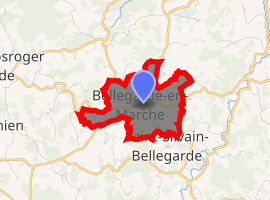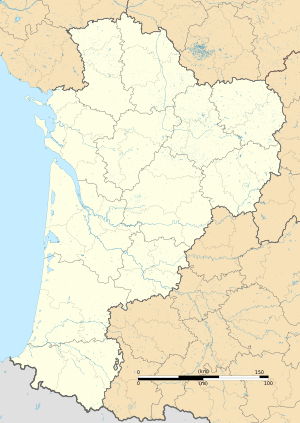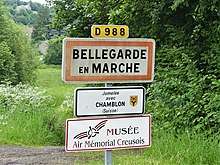Bellegarde-en-Marche
Bellegarde-en-Marche (Occitan: Bèlagarda) is a commune in the Creuse department in the Nouvelle-Aquitaine region in central France.
Bellegarde-en-Marche | |
|---|---|
 Coat of arms | |
Location of Bellegarde-en-Marche 
| |
 Bellegarde-en-Marche  Bellegarde-en-Marche | |
| Coordinates: 45°58′58″N 2°17′43″E | |
| Country | France |
| Region | Nouvelle-Aquitaine |
| Department | Creuse |
| Arrondissement | Aubusson |
| Canton | Aubusson |
| Intercommunality | CC Marche et Combraille en Aquitaine |
| Government | |
| • Mayor (2008–2014) | Jean-Pierre Bonnaud |
| Area 1 | 3.14 km2 (1.21 sq mi) |
| Population (2017-01-01)[1] | 409 |
| • Density | 130/km2 (340/sq mi) |
| Time zone | UTC+01:00 (CET) |
| • Summer (DST) | UTC+02:00 (CEST) |
| INSEE/Postal code | 23020 /23190 |
| Elevation | 530–648 m (1,739–2,126 ft) (avg. 603 m or 1,978 ft) |
| 1 French Land Register data, which excludes lakes, ponds, glaciers > 1 km2 (0.386 sq mi or 247 acres) and river estuaries. | |
History
Bellegarde is a bastide (fortified village) created in the 13th century, during the defence of the Limousin against the English who then disputed territory in Western metropolitan France (Guyenne). King Louis VIII, fighting against Henry III, the English king, decided to establish a forward military post in Bellegarde.[2] It took its current name in 1892.
- It is the former capital of the Franc-alleu, a medieval free-trade zone at a crossroads between two powerful regions: Auvergne and Limousin.
- In the wake of Aubusson and Felletin, tapestry workshops were set up in the city during and after the Renaissance. Bellegarde was even considered for a time a "rival" of Aubusson and Felletin in this activity.
Geography
A farming village situated some 5 miles (8.0 km) northeast of Aubusson at the junction of the D9, D39, D40a and the D988 roads.
Population
| Year | Pop. | ±% |
|---|---|---|
| 1962 | 404 | — |
| 1968 | 413 | +2.2% |
| 1975 | 417 | +1.0% |
| 1982 | 407 | −2.4% |
| 1990 | 425 | +4.4% |
| 1999 | 425 | +0.0% |
| 2008 | 434 | +2.1% |
Sights
- The church, dating from the nineteenth century.
- A sixteenth-century tower.
- Some very old houses.
- Remains of a feudal castle.
- The chapel of Notre-Dame, dating from the nineteenth century.
- Tour Jacqueron, a defensive tower marking the East end of the old Bastide.
 Tour de l'horloge (clock tower)
Tour de l'horloge (clock tower) Mairie (Townhall) and Post Office
Mairie (Townhall) and Post Office.jpg) Turett from the Chevanne House (Maison Chevanne), which is a local Air Memorial Museum, a tourism office and a public library
Turett from the Chevanne House (Maison Chevanne), which is a local Air Memorial Museum, a tourism office and a public library Bellegarde-en-Marche has a long history of goat-eating, one of its streets was paved with goats' horns
Bellegarde-en-Marche has a long history of goat-eating, one of its streets was paved with goats' horns As Bellegarde developed in the XVIIth Century, new houses were built. This one is dated 1666
As Bellegarde developed in the XVIIth Century, new houses were built. This one is dated 1666 Tour jacqueron, the East end of the old village
Tour jacqueron, the East end of the old village Grand Rue ("main street") with its pharmacy
Grand Rue ("main street") with its pharmacy
Personalities
- François Goubert (1735-1815), is a clergyman and a politician. Prefect of Aubusson in 1762, he became parish priest in Bellegarde in 1788 and official of Chénérailles. He was elected deputy of the Creuse clergy in 1789.
- François Denhaut (1877–1952), an early French aviator & engineer who invented and tested a type of flying boat, died here.
- Lionel de Marmier (1897-1944), born in Bellegarde-en-Marche, pilot of the French Air Force and resistance fighter, a figure of free France.
International relations
Bellegarde-en-Marche is twinned with:
gollark: My site is definitely not that popular.
gollark: There was a minor bot issue.
gollark: I didn't put much thought into it.
gollark: I don't know. Weird design quirk.
gollark: The best part is that the counter is globally shared, so everyone sees the same value, excepting a bit of network lag.
See also
This article is issued from Wikipedia. The text is licensed under Creative Commons - Attribution - Sharealike. Additional terms may apply for the media files.
